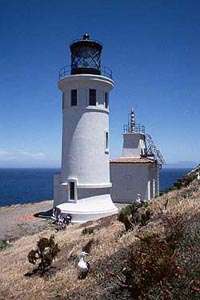Fort Point Light, San Francisco
.jpg) Fort Point Light | |
 California | |
| Location |
just below the Golden Gate Bridge San Francisco California United States |
|---|---|
| Coordinates | 37°48′38″N 122°28′38.4″W / 37.81056°N 122.477333°WCoordinates: 37°48′38″N 122°28′38.4″W / 37.81056°N 122.477333°W |
| Year first constructed | 1855 (first) |
| Year first lit | 1864 (current) |
| Deactivated | 1934 |
| Foundation | brick and granite third system fortification |
| Construction | cast iron skeletal tower |
| Tower shape | nonagonal frustum skeletal tower with balcony and lantern |
| Markings / pattern | white tower, black lantern |
| Height | 27 feet (8.2 m) |
| Focal height | 110 feet (34 m) |
| Original lens | Fourth order Fresnel lens (1864) (removed) |
| Characteristic | Fl WR 5s. |
| ARLHS number | USA-295 |
| Managing agent |
Fort Point National Historic Site[1] [2] |
Fort Point Light was a lighthouse on Fort Point, directly beneath the south anchorage of the Golden Gate Bridge in San Francisco, California. It was added to the National Register of Historic Places in 1970, reference #70000146.
Structures
There have been three lighthouses at Fort Point.
The original lighthouse, built in 1853, was a Cape Cod style lighthouse with an integral tower. It stood for only three months, and was never lit. While awaiting the arrival of its lens (from Paris), it was torn down to make room for the Army fort.
The second lighthouse at Fort Point was a squat wooden 36-foot (11 m) tower with four sides that sloped up to a square watch room. It was built on the narrow ledge between the fort and the water. In 1855, the light behind its fourth-order Fresnel lens was lit for the first time. Erosion undermined its foundation, and in 1863 it was torn down to make way for a bigger seawall.
Fort Point’s third lighthouse was built atop the wall of the fort. It was originally a small iron skeleton tower with a fifth-order lens. In 1902, the lens was upgraded to a fourth-order lens, which produced alternating white and red flashes.
In 1933, when work on the Golden Gate Bridge began, a fog signal and navigational light were placed at the base of the bridge’s south tower. In 1934, when the towers for the Golden Gate Bridge were completed, the lighthouse was deactivated. The bridge would block off much of the light from the lighthouse, and as the towers were 740 feet (226 m) tall, they provided a more visible warning for mariners.
Keepers
Early keepers of Fort Point Light included:
- B. F. Deane (1855-?)
- J. C. Frachey (?)
- George D. Wise (1860)
- Henry Hickson (1860-?)
- John D. Jenkins (?-1863)
- George W. Omey (1863)
- Scott Blanchard (1864–1866)
- R. S. Martin (1866–1869)
- Frank Thompson (1869–1871)
- J. T. Hule (1871–1878)
- James Rankin (lighthouse keeper) (1878–1919)
- George D. Cobb (lighthouse keeper) (?-1939)
Assistant keepers included:
- Ephrin Sohn (1856-?)
- Return J. Henter (1857–1859)
- George D. Wise (1858–1860)
- D. Dennison (1860)
- G. W. Thomas (1860)
- James Gormley (1860-?)
- James Jenkins (1860-?)
- James Heron (1860-?)
- C. H. Warren (?)
- G. W. Omey (?-1863)
- G. A. Braley (1863)
- J. J. Wickersham (1863–1865)
- Ann Blanchard (1865–1866)
- William Ferry (1866–1867)
- Mrs. Rachel L. Jones (1867–1868)
- Theresa Welch (1868)
- F. B. Morehouse (1868–1869)
- Mrs. Mary Thompson (1869–1871)
- Sophie Hule (1874–1878)
- John Riley (1878–1879)
- H. P. McKeever (1879)
- Frank P. Stanyan (1879)
See also
References
- ↑ Fort Point The Lighthouse Directory. University of North Carolina at Chapel Hill. Retrieved 10 June 2016
- ↑ California Historic Light Station Information & Photography United States Coast Guard. Retrieved 10 June 2016
External links
| Wikimedia Commons has media related to Fort Point Light (California). |
- United States Coast Guard
- National Park Service Fort Point Page
- Fort Point Lighthouse Page www.us-lighthouses.com
- "Historic Light Station Information and Photography: California". United States Coast Guard Historian's Office.
- U.S. Geological Survey Geographic Names Information System: Fort Point Lighthouse (historical)
